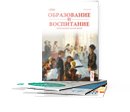The article presents the results of the analysis of a set of metal parts from one pit burial of the Saltovo-Mayaki culture, discovered as a result of archaeological excavations of the Mandrovsky burial ground in 2000–2003. In the set of parts, consisting of a buckle and seven plaques, two complexes were identified (parts of a belt and horse harness decorations). Analogies were traced for the finds from archaeological sites of the Don region, Crimea, the Volga region and the North Caucasus. Based on the relative chronological table developed for the antiquities of the Dmitrievsky burial ground, the time of appearance of the burial under study was attributed to the second quarter of the 9th century.
Keywords : Mandrovsky burial ground, Saltovo-Mayak culture, belt headset, belt buckle, belt plaque, analogyэ
The belt headsets of the population of the Saltovo-Mayak culture of the mid-8th — early 10th century have been studied in detail to date. Archaeological science in Russia and in the post-Soviet space has accumulated a large volume of material sources, they are analyzed in numerous special works. The downside of these studies is the inconsistency of chronological dating and classifications proposed by researchers for different regions and monuments [1; 2; 3; 4]. For this reason, the question of the internal chronology of the antiquities of the Saltovo-Mayak culture remains relevant for future studies.
In this article I attempt a typological and chronological analysis of a set of metal parts of a belt headset from one pit burial of the Mandrovsky burial ground. The archaeological site is located in the Middle Don region on the dune hills of the first terrace of the right bank of the Valui River (a left tributary of the Oskol River) and is situated within the administrative boundaries of the Valui urban district of Belgorod region, 0,8 km west of the Mandrovo village. The burial ground was discovered in the mid-1990s by a local school teacher S. V. Zelensky. As a result of archaeological research carried out in 2000–2003 by a team of the Lipetsk Pedagogical University under the direction of V. A. Sarapulkin the monument was studied on the area of 1200 sq. m. Archaeologists discovered forty-nine burials, three horse burials, traces of the five funeral repasts and thirty-two multi-temporal pits (mostly of the modern era). The artifacts collected during the excavations made it possible to determine the time of the burial ground functioning in the first half of the 9th century [20, p. 44].
Burial 17 was located in the south-western part of excavation 1. The rectangular-shaped grave pit stood out against the background of light clay filled with gray loam. It measured 2 m by 0,65 m and was oriented along the east-west line. In the northern wall at a height of 0,35 m there was a step in its entire length. The skeleton was placed in anatomical order with the head to the west. Five belt plaques and a belt buckle were found near the skeleton’s waist. Two plaques were found on a step near the deceased's skull, suggesting that these were parts of horse harness [20, p. 12–13]. The analysis seems to start with these artifacts.
A rectangular bronze slotted plaque [20, fig. 15.4] is classified as style 3 type 3 according to the typology of S. A. Pletneva [16, p. 78]. The upper edge of the artifact is stylized with the so-called «lotus-shaped» ornament, while its extreme simplification is striking, to the point that it is difficult to discern the plant motifs of the ornament as such in the image. Apparently, the prototype of the ornament should be sought in images of an «unfolded» palmette framing the slotted opening. Similar objects are quite widely known from materials from the 9th century in the zone of the Don-Donetsk variant of the Saltovo-Mayak culture — in the collection of the Mayatskoye settlement [15, fig. 2.4], complexes from the burial catacombs 51, 89, 124 of Dmitrievsky [16, fig. 86–87] burial ground, catacomb 22 of Verkhnesaltovsky-I [5, fig. 4.78] and catacomb 67 of Verkhnesaltovsky-IV burial grounds [5, fig. 4.80], catacomb 2 of Podgorovsky burial ground [17, fig. 2.11] and materials from burial 40 of Zlivkinsky burial ground [6, fig. 4.3].
A bronze oval-shaped slotted plaque with a round hole in the center and three round projections [20, fig. 15.7] cannot be precisely correlated with the proposed typology, but according to a number of morphological features it should be attributed to the plaques of style 3 [16, p. 78]. The ornamentation of the item depicts a lotus stem with three inflorescences extending from it. Analogies to the artifact are well known both in the monuments of the Podonechie region of the 9th — early 10th centuries, and beyond its borders in the area of distribution of the Saltovo-Mayak culture. Similar plaques are present in the composition of belt sets from the burials of the Bolshe-Tarkhansky burial ground [4, tab. XVII.8, 9], catacomb 124 of the Dmitrievsky burial ground [16, fig. 87], catacomb 1 of the Podgorovsky burial ground [17, fig. 2.12], among the random finds from the cultural layer of the Sidorovsky settlement [12, fig. 209.31].
Now let us turn to the analysis of the metal parts of the belt. The bronze cast oval-frame belt buckle [20, fig. 15.1] has a shield in the form of a trapezoid frame, the base of which faces the tongue attached to the frame, and belongs to type 2 according to the typology of S. A. Pletneva [16, p. 77]. Analogies of this artifact are known in the materials of many monuments of the Khazar Khaganate of the second half of the 8th — early 10th centuries. Similar buckles have been studied in the burial catacombs of the late (catacombs 5, 83, 88, 143) group of the Dmitrievsky burial ground [16, fig. 85–86]. A similar find was also discovered at the Netailovsky burial ground in catacomb 492 [1, Fig. 10.1]. Such finds have been studied in burial monuments of the Don region — materials from mound 2 of the Salovsky-I burial ground, mound 1 of the Romanovsky-I burial ground [7, fig. 3.10, 24] and mound 7 of the Petrunino-IV burial ground [10, fig. 3.47]. A similar item was found in Sarkel in burial 234, which belongs to the first period of its functioning [2, fig. 13].
Buckles of similar design have been studied at archaeological sites in Crimea in the burials of the Skalistinsky burial ground [11, tab. XVII.14], in the North Caucasus, for example, based on the find from burial mound 6 of the Verkhne-Chiryurtovsky burial ground [14, fig. 25.6], and in the Volga region based on the belt sets of the Bolshe-Tarkhansky burial ground [4, tab. XVII.2]. Perhaps the lower chronological boundary of the distribution of such buckles should be considered the first quarter of the 8th century, the time of which is dated by the finds of buckles from the cultural layer of Penjikent [18, fig. 61.4–7].
The heart-shaped belt plaque [20, fig. 15.8] can be classified as style 1 type 3 according to the proposed typology [16, p. 77]. Similar items were discovered in the late catacombs 7 and 71 of the Dmitrievsky burial ground [16, fig. 86]. Similar finds are known from the materials of the catacomb I of the Mayatskoye settlement [21, fig. 1.3] and crypt 391 of the Skalistinsky burial ground [19, fig. 64.22]. A plaque from burial 171 of the Bolshe-Tarkhansky burial ground [4, tab. XVII.2] should be classified as similar in shape; however, this item was attached to the belt not with one, but with three pins.
A round plaque with a movable ring [20, fig. 15.6] can be related to type 5 of style 2 according to the typology of S. A. Pletneva [16, p. 78]. The ornamentation of the item is represented by an image of three lotus flowers, directed in different directions, and two shoots between them. Similar plaques are often found in archaeological sites of the Saltovo-Mayak culture, but exact analogies have been traced in finds from catacomb 169 of the Dmitrievsky burial ground [16, fig. 87] and a burial near the town of Chistyakovo [13, fig. 3.1].
The plaque with a movable ring and a pentagonal shield [20, fig. 15.5] is associated with type 4 of style 2 of the proposed typology [16, p. 78]. The conventional ornament applied to the shield most likely depicts three upward-facing lotus flowers. Analogies of the plaque are known from finds in catacomb 5 of the Podgorovsky burial ground [17, fig. 2.3], early catacombs 51 and 87 of the Dmitrievsky burial ground [16, fig. 85], burial 376 of the Netailovsky burial ground [5, fig. 5.117] and catacombs 37 and 118 of the Verkhnesaltovsky-IV burial ground [5, fig. 5.98, 97].
A rectangular cut-out plaque [20, fig. 15.3], along three sides of which small depressions are traced, did not fall into the typology of plaques developed by S. A. Pletneva, but in its design it is close to the objects of style 3 [16, p. 77]. Apparently, the analyzed artifact is a copy of plaques decorated with plant ornamentation, and their corners were designed to look like leaves. Such objects are known from the early catacomb 111 of the Dmitrievsky burial ground [16, fig. 85] and from materials from burial sites in Crimea, for example, burial 11 of the Tepsen settlement [9, tab. 3.4, 9] and crypt 246 of the Skalistinsky burial ground [19, fig. 3.31].
The subrectangular openwork plaque [20, fig. 15.2] is related to the items of style 3 type 2 according to the proposed typology [16, p. 78]. The upper edge of the plaque is decorated with a schematic «lotus-shaped» ornament. The plaque is most similar to items from catacombs 21, 87, 155 of the Dmitrievsky burial ground [16, fig. 86–87], burial 77 of mound 3 of the Krasnaya Gorka burial ground [5, fig. 4.118], burial 145 of the Bolshe-Tarkhansky burial ground [4, tab. XVII.14].
So, we can make a few preliminary remarks. Firstly, the set of metal parts from burial 17 of the Mandrovsky burial ground, which I preparatory assigned to two belts, have typical features for the Saltovo belt set. Apparently, this is a consequence of the spread of the pan-Turkic fashion on the territory of the Khazar Khaganate, which manifested itself in similar forms of belt parts, horse harness and weapons, which covered the Eurasian steppes in the 7th — 9th centuries [3, p. 158].
Secondly, the presence of a set of belt parts in the accompanying inventory of burial 17 along with elements of horse harness and weapons allows us to characterize it as a burial of a rider, which is also a traditional feature of burial archaeological sites of the Saltovo-Mayaki culture. Belt set parts almost always come from male burials with a specific composition of inventory associated with horse riding and weapons.
Thirdly, a specific feature of the metal parts of burial 17 is the extreme schematicity of the ornament, up to complete stylization, when it is difficult to catch the plant motifs of the ornament as such in the images. The schematic nature of the ornament is traced on four plaques, and may indicate the presence of a certain production tradition.
In sum, we can note that the greatest similarity between the metal parts of the belt from burial 17 of the Mandrovsky burial ground is found in the materials of the Dmitrievsky burial ground. Moreover, the buckle and plaques of the belt have analogies in both the early and late groups of catacombs. Of course, it is worth determining the lower chronological boundary of the appearance of the burial based on the late complexes. According to the data of the chronological scale proposed by S. A. Pletneva, the catacombs of the second (late) group were сreated by the population of the Dmitrievsky settlement in the second half of the 9th — early 10th century [16, p. 172]. This, however, contradicts the data on the time of operation of the Mandrovsky burial ground, which was сreated in the first half of the 9th century.
A different view of the problem was laid down in the concept of A. V. Komar [8, p. 57]. The scientist divided all sets of Dmitrievka belt details into three horizons, determining the time of the emergence of horizon II as the end of the 8th — beginning of the 9th century. The materials of horizon III, according to the researcher, demonstrate the process of evolution of the belt of the set of horizons II. However, absolute dates of horizon III were not established in his publication.
Taking this version into account, I will present my view on the dating of burial 17 of the Mandrovsky burial ground. It can be said with a high degree of certainty that the set of metal parts of the belt set fell into the ground in the first half of the 9th century. At the same time, two plaques of the horse harness are later and are related to the plaques of horizon III of the Dmitrievsky burial ground [8, fig. 4.1]. The parts of the belt are similar to the plaques from horizons II and III [8, fig. 4.1, 2]. Consequently, the belt reflected a transitional stage in the development of the belt set between the horizons and had a mixed origin, which is not surprising, since the Saltovsky belts could often be supplemented with new plaques during wear [3, p. 159]. Unfortunately, it is hardly possible to clarify the absolute dating using other items of accompanying inventory, since the artifacts found in burial 17 have a wide period of existence within the Saltovo-Mayaki culture itself.
Thus, in accordance with the above, we can clarify the time of burial 17 of the Mandrovskoye burial ground and preliminarily attribute it to the second quarter of the 9th century.
References:
1. Aksyonov V. S. Pogrebeniya vsadnikov Netajlovskogo mogilnika saltovskoj kultury: tipologiya i hronologiya (po materialam 2003–2010 godov) [Burials of horsemen of the Netaylovskiy burial ground of the Saltovskaya culture: typology and chronology (based on materials from 2003–2010)] // Stepi Evropy v epohu srednevekovya. — Doneck, 2012. — T. 9. Hazarskoe vremya. — pp. 207–242.
2. Artamonova O. A. Mogilnik Sarkela-Beloj Vezhi [Sarkel-Belaya Vezha burial ground] // Materialy i issledovaniya po arheologii SSSR. — Moskva-Leningrad, 1963. — № 109. — pp. 9–215.
3. Fonyakova, N. A. Vostochnye elementy v prikladnom iskusstve Hazarii (vtoraya polovina VIII — nachalo X vv.) [Eastern elements in the applied art of Khazaria (second half of the 8th — beginning of the 10th centuries)] / N. A. Fonyakova // Srednevekovaya arheologiya evrazijskih stepej. Materialy Uchreditelnogo sezda Mezhdunarodnogo kongressa. Ser. «Arheologiya evrazijskih stepej»: Kazan, 14–16 fevralya 2007 g. — T. II. — Kazan: In-t istorii AN RT, 2007. — pp. 158–173.
4. Gening V. F., Halikov A. H. Rannie bolgary na Volge (Bolshe-Tarhanskij mogilnik) [Early Bulgarians on the Volga (Bolshe-Tarkhansky burial ground)]. — Moskva, 1964. — 202 p.
5. Golubev A. M. Hronologiya saltovskih drevnostej Verhnego Podoncovya v kontekste vengerskoj problematiki [Chronology of Saltov antiquities of Upper Podontsovye in the context of Hungarian issues] // III Mezhdunarodnyj madyarskij simpozium po arheologii. — Budapesht, 2018. — pp. 367–400.
6. Grib V. K., Shevcov M. L. Serebryanyj poyas iz pogrebeniya 40 mogilnika Zlivki [Silver belt from burial 40 of the Zlivki cemetery] // Arheologiya kak zhizn. Pamyati Evgeniya Pavlovicha Myskova. Sbornik statej. — Volgograd, 2019. — pp. 158–173.
7. Ivanov A. A., Kopylov V. P., Naumenko S. A. Poyasnye nabory iz kurganov hazarskogo vremeni mezhdurech'ya Sala i Dona [Belt sets from burial mounds of the Khazar period between the Sala and Don rivers] // Donskaya arheologiya. — Rostov-na-Donu, 2000. — № 1. — pp. 81–90.
8. Komar A. V. Gorizont Stolbishche-Starokorsunskaya i nekotorye problemy vozniknoveniya saltovskoj kultury [The Stolbishche-Starokorsunskaya horizon and some problems of the origin of the Saltovskaya culture] // Finno-Ugrica. — Kazan, 2000. — № 1. — pp. 42–67.
9. Komar A. V. Predsaltovskie i rannesaltovskij gorizonty Vostochnoj Evropy (voprosy hronologii) [Pre-Saltov and early Saltov horizons of Eastern Europe (questions of chronology)] // Vita antiqua. — Kiev, 1999. — № 2. — pp. 111–136.
10. Komar A. V. Proiskhozhdenie poyasnyh naborov rannesaltovskogo tipa [The origin of the early Saltov type belt sets] // Kultury evrazijskih stepej vtoroj poloviny I tysyacheletiya n. e. (iz istorii kostyuma). — Samara, 2001. — T.2. — pp. 103–117.
11. Kovalevskaya V. B. Poyasnye nabory Evrazii IV–IX vv. Pryazhki [Belt sets of Eurasia IV-IX centuries. Buckles] // SAI. V. E1–2. — Moskva, 1979. — 58 p.
12. Kravchenko E. E. Sidorovskij arheologicheskij kompleks na r. Severskij Donec [Sidorovsky archaeological complex on the Seversky Donets river]. — Kazan, 2020. — 344 p.
13. Kravchenko E. E., Shamraj A. V. Pogrebalnye kompleksy hazarskogo vremeni s baklagami s territorii Doneckoj oblasti [Burial complexes of the Khazar period with flasks from the territory of Donetsk region]. — Rostov-na-Donu, 2000. — № 3–4. — pp. 70–82.
14. Magomedov M. G. Obrazovanie Hazarskogo kaganata [Formation of the Khazar Khaganate]. — Moskva, 1983. — 224 p.
15. Makarova T. I., Pletnyova S. A. Poyas znatnogo voina iz Sarkela [Belt of a noble warrior from Sarkel] // Sovetskaya arheologiya. — Moskva, 1983. — № 2. — pp. 64–76.
16. Pletnyova S. A. Na slavyano-hazarskom pogranich'e (Dmitrievskij arheologicheskij kompleks) [On the Slavic-Khazar border (Dmitrievsky archaeological complex)]. — Moskva, 1989. — 288 р.
17. Pletnyova S. A. Podgorovskij mogilnik [Podgorovskij burial ground] // Sovetskaya arheologiya. — Moskva, 1962. — № 3. — pp. 241–251.
18. Raspopova V. I. Metallicheskie izdeliya rannego Sogda [Metal products of early Sogdiana]. — Leningrad, 1980. — 138 p.
19. Vejmarn E. V., Ajbabin A. I. Skalistinskij mogilnik [Skalistinsky burial ground]. — Kiev, 1993. — 204 р.
20. Vinnikov A. Z., Sarapulkin V. A. Bolgary v Pooskolie (Mandrovskij mogilnik) [Bulgarians in Pooskolye (Mandrovsky burial ground)]. — Voronezh, 2008. — 107 p.
21. Vladimirov S. I. Hronologiya pogrebenij Mayackogo selishcha (po detalyam poyasnyh naborov) [Chronology of burials in the Mayatskoye settlement (based on details of belt sets)]// Divnogorskij sbornik. — Voronezh, 2021. — T. 8. — pp. 177–186.







